Employment[editar]
The European Roma population, because of low levels of schooling and a lack of professional training as well as discriminative practices by employers, remains to a large extent marginalised from the formal labour market. This labour market situation is conditioned by traditions and historical reasons, including high segregation levels, educational deficiencies (poor schooling and high early drop-out rates), low participation in regular training schemes, but also inter-subjective perceptions and discrimination in training and employment. You can check Fundamental Rights Agency Agency "Transition from education to employment of young Roma in nine EU Member States". 2018
Notwithstanding significant national differences, the average unemployment rate of Roma aged 20 to 64 in the EU is estimated to reach 35% (77% in the case of the Czech Republic), while less than a third of Roma are reported to be in paid employment. In France, Italy and Portugal, only about ten percent of adult Roma are in salaried employment. In Spain, at the height of the economic boom (2005), the Roma population registered significantly higher unemployment rates than the general population (13.8 percent compared to 9 percent overall). Yet Spain’s labour market crisis has disproportionately affected Roma and other groups in precarious employment (chiefly in the service sector), causing almost a tripling of unemployment rates to 38% by 2012.
The low employment rates of Roma are partly related to high rates of self-employment: circa 20% of the Roma surveyed in France and Greece, 25% in Italy, and 35% in Spain (matching in the latter case a rapid decline of salaried employment in the context of crisis) have reported that they are self-employed.
Gender imbalances within the Roma community, which entrench multiple forms of discrimination and inequalities, are manifest in the fact that women are generally affected by lower activity rates, higher unemployment rates and more limited employment opportunities than Roma men.
Roma participation in informal labour activities is on average four (or more) times more prevalent than in the majority population in the EU, however with significant national discrepancies in this regard: for instance, in 2004 (data for 2011 is pending publication by the EC, FRA and UNDP), 41% of the Roma active population worked in informal activities in Bulgaria, 22% in the Czech Republic, 42% in Hungary, 42% in Slovakia, 50% in Spain and 70% in Romania.
Low formal educational levels and lack of qualifications, combined with discrimination in the access to work, confines the majority Roma to unskilled and precarious employment. In 2004 (data for 2011 pending publication), almost 67 percent of European Roma are employed in unskilled or semi-skilled jobs, compared to just 16 percent of majority respondents.
High unemployment, underemployment and inactivity rates contribute significantly to high poverty rates among Roma (including child malnutrition). High poverty and unemployment rates among the Roma generate a cycle of dependency on state welfare that is difficult to break: if pensions are included as part of state benefits, the level of dependency reaches 24% of Roma households in the Czech Republic, 48% in Bulgaria and 55% in Hungary. However, the confinement in informal activities of a high proportion of Roma signifies that large numbers fail to pay the taxes required to finance social security: According to the UNDP, ‘This causes “asymmetrical” Roma participation in social welfare systems: active regarding benefits, limited regarding contributions. This asymmetry can further promote exclusion and ethnic intolerance’.
To know about employment and Roma community in Spain and about Acceder Programme








